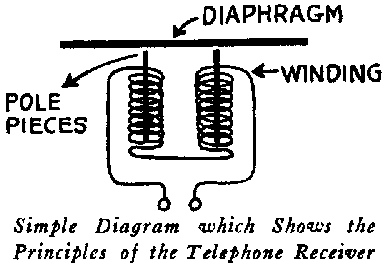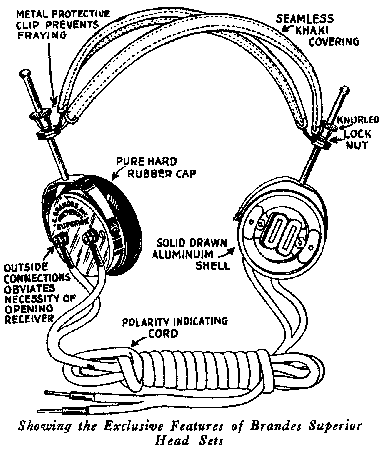RADIO TELEPHONE AND TELEGRAPH RECEIVERS
We are now getting to the most important part of a receiving outfit. We refer to the 'phones. A receiving outfit cannot be more sensitive than its 'phones. All the rest of the outfit may perform efficiently, but if the 'phones are badly designed and poorly constructed a good percentage of the feeble little currents that are led into them will be destroyed and the signals, speech or music will be greatly reduced in volume. We must come to look upon the 'phones as the instruments that convert the electrical impulses or currents into audible sounds. This delicate process must be effected with the least possible waste, since we can readily understand that no part of these feeble currents can be lost.
So many beginners make the mistake of buying a good receiving set without laying emphasis upon the 'phones they purchase with it. The price of a receiving set is immaterial, since the 'phones that are purchased with it determine its efficiency and sensitiveness. A $100.00 outfit will perform like a $15.00 outfit if the 'phones that are used are unable to make the most of the weak currents they receive from the detector. The mere fact that we cannot hear signals and music without 'phones should impress us with their importance.
A receiving aerial may pick up a signal and it will be carried to the tuning coil. After passing this point, it reaches the detector where it is rectified. All of this may take place very efficiently. The aerial, the tuning coil and the detector will handle the signal in such a way that little or none of it is lost. All of this efficiency on the part of these instruments may come to naught if the 'phones fail to do their part. If they are not scientifically designed and constructed, the signal strength will be lost and only a comparatively small percentage of the current will be converted into sound. There must be a perfect co-relation between the various working parts of the receiver. So many manufacturers have made the mistake of designing 'phones by rule of thumb. The Brandes receivers have been developed over a period of twelve years. They were originally designed by Reginald Fessenden, one of the world's greatest radio experts.

A few words will now be devoted to the operation of a telephone receiver. How are these weak currents converted into audible sound? That is the question we want answered. Although marvelously sensitive, the operation of the Brandes 'phone is quite simple. In the diagram we will see how a receiver is connected electrically. Two electromagnets are placed within the receiver. These magnets, which are made of electric iron, have wound about them many turns of very fine wire, made of the purest copper. A few thousands of an inch above the magnets or the pole pieces, as they are sometimes called, the diaphragm is clamped. The diaphragm is an extremely thin sheet of metal, properly coated and perfectly flat.

When an electric current travels through a wire, a magnetic field is set up about that wire. A magnetic field is nothing more or less than a magnetic influence the same as that which we find existing at the pole of a cheap little horseshoe magnet. The strength of this magnet field about a wire depends upon the strength of the current passing through it. In the case of radio currents, a very weak magnetic field is set up about the wires that they pass through. Therefore, if we wish to take advantage of this magnetic field in any way, we must concentrate it so-to-speak. If a large amount of wire is wound into a coil the magnetic field produced will be more or less "bunched." This is done in a telephone receiver. A very fine wire about the size of a human hair is wound about the magnets of the receiver. Wire of this size is used so that a maximum number of feet can be crowded into a minimum space, since it is upon this that much of the efficiency of the receiver depends.
When radio currents pass through the electro-magnets or telephone receivers, a magnetic field is set up which is strongest at the pole pieces. This magnetic influence tends to pull the diaphragm of the receiver down and other forces are at work trying to keep it in its original position. Since the incoming current fluctuates, the magnetic field fluctuates with it and this causes the diaphragm to vibrate in symphony with the currents. This vibration of the diaphragm sets the air in motion and a sound is created. In this way the signals or speech produced at the distant sending station are reproduced at the receiving station. Without telephone receivers wireless would be impossible.
Good receivers are built like watches. The receiver case is made of solid aluminum with machine-cut threads to accommodate the pure hard rubber caps which keep the diaphragm pressed tightly in place over the pole pieces. To be efficient, there should be but a few thousandths of an inch of space between the diaphragm and the pole pieces. In manufacturing the Brandes 'phone, this distance is carefully determined with micrometer measuring instruments. The receiver cases are ground on precision machinery until exactly the right distance is reached.
Cheaply made 'phones are not properly protected on the inside and consequently the parts rust and corrode. This cannot happen with Brandes receivers, since they are heavily nickel-plated and lacquered to prevent action of this kind.
Matched-tone * is another exclusive Brandes feature. The receivers on each head-set are carefully selected by experts so that the sound produced in each receiver will be of exactly the same volume and of the same pitch. Although the work of matching these receivers in tone is costly, the result produced is well worth the effort. Maximum sensitivity of receivers cannot be had when the signals sound differently in each receiver. If one receiver was louder than the other, the signals would sound "mushy" and the user would unconsciously concentrate his attention on one receiver alone. As a result of this, the advantage of having two receivers would be lost. With the Brandes Matched-Tone * headset the sound produced in each receiver is of the same volume. The user does not experience the confusing sensation of listening to apparently two stations sending the same message.

Too much importance cannot be attached to the headband of wireless sets. They must be designed in such a way that the receivers will rest on the head naturally. Headbands should also be adjustable so that the receivers can be fitted to the ears. Brandes receivers are extremely flexible in this way and they can be instantly adjusted by simply loosening two small thumb nuts. The headband is covered with seamless khaki, provided with metal ends to prevent fraying. The hard rubber receiver caps are shaped to fit the ear and their velvety smooth finish, which prevents skin abrasion, cannot wear off as in the case of cheap moulded caps of composition.
To render good service, receivers should also be sensitive to currents with a wide range of frequencies. Radio currents do not "vibrate" at the same rate. A receiver must be designed and constructed in such a way that it will be sensitive to all frequencies. Actual tests have proven that the Brandes receivers leave nothing to be desired in this connection. When tested with various other makes they prove to be the most efficient.
The beginner is apt to make the mistake of purchasing a horn attachment for his receiver, thinking that this combination will provide him with what is known as a loud speaker. The results obtained with such an arrangement will be extremely disappointing. The volume of the sound will be small and much of the music or speech will be lost unless those present crowd closely about the horn. If the station owner desires to make the music received by his outfit accessible to the entire household, he will find it best to buy several headsets and connect them in series. With such an arrangement each member of the family will be sure to hear the music or speech without losing any of it and without distortion. The clear reproduction heard in a Brandes receiver cannot be duplicated with a loud speaker. This holds true for all types. The loud speaker is in a comparatively crude state as yet, and, although great volume can be obtained, a sacrifice in purity is necessary.
_____________
* Rev. U. S. Pat. Office